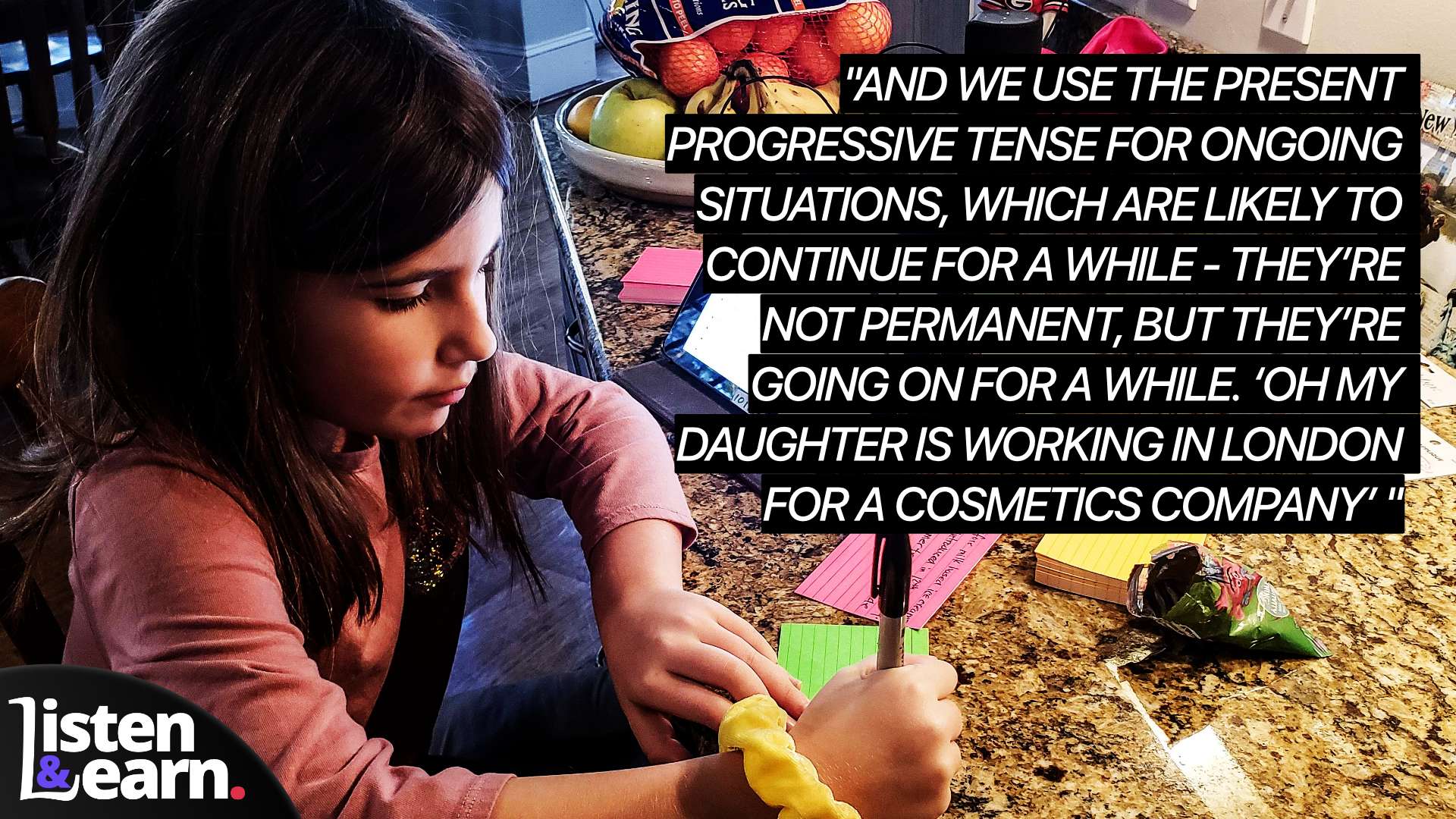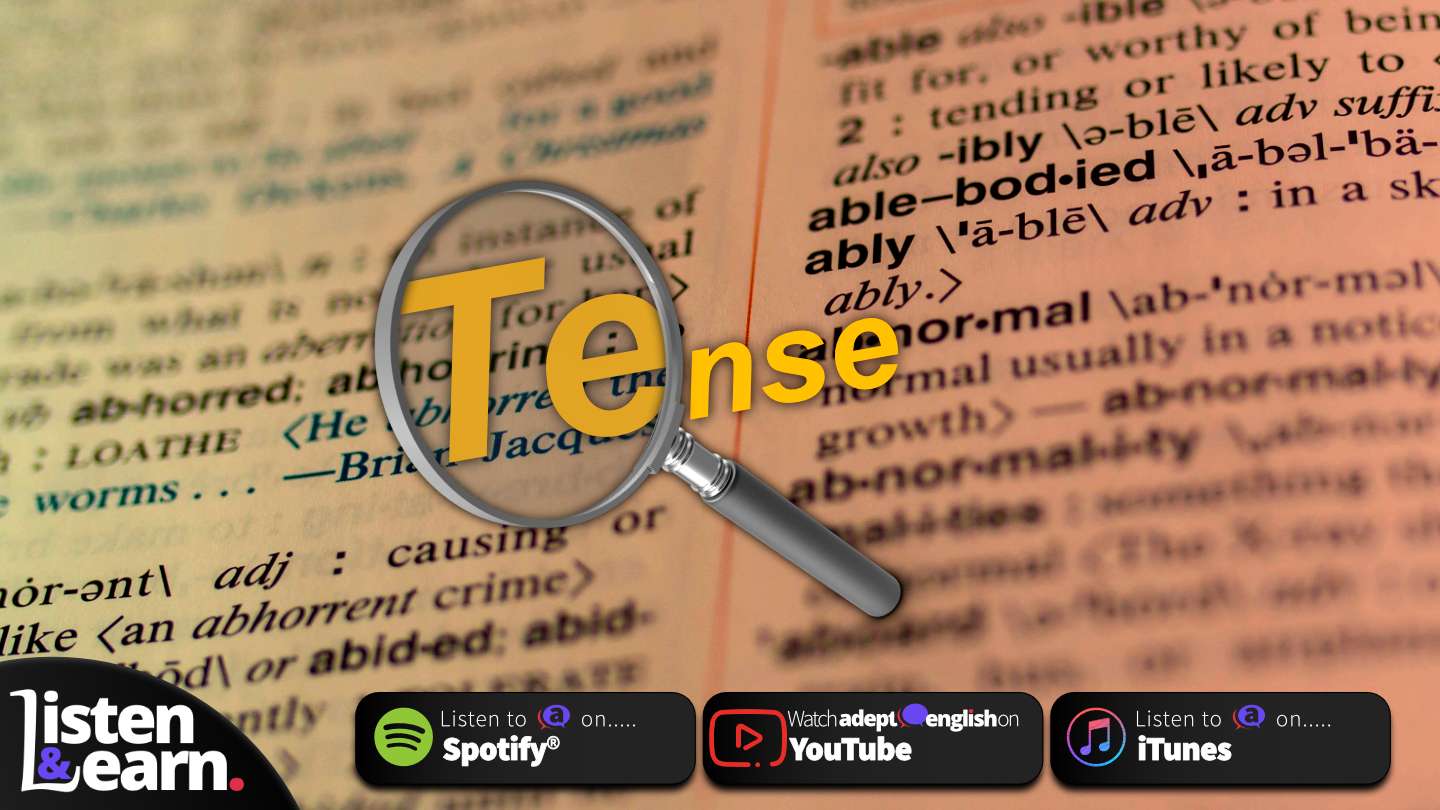An English Grammar Podcast Lesson That Focuses On The Present Tense
The PRESENT TENSE in English: We’re going to work on the present tense in our English grammar lesson today. I want to get you thinking about how you can use your knowledge of the tenses to your advantage when speaking. We use tenses to explain when an action takes place, and explaining when an action takes place is an important part of ALL our everyday conversations.
So what is present tense? The present tense is one of the verb tenses in English and is used to describe actions that are currently happening, or include routine actions that are true. I'm sure there are more formal definitions, but this is how I think of it, and it's a practical way to think about it.
First the good news, present tense conjugation is pretty simple in English. You can just listen and learn these. However, and the reason for today’s lesson, the other forms of the present tense can be difficult to learn through listening alone. So in this English grammar podcast, we’re going to walk through each form of present tense and explain what you should watch out for when you listen and learn English.
As always, there are lots of examples in this English lesson, and because it’s important that you really do grasp the different forms, I’ve included a quick test at the end of the lesson to check your understanding.
Most Unusual Words:
Advantage
Routine
Conjugation
Formal
Proactive
Progressive
Replay
Cosmetics
Most common 2 word phrases:
| Phrase | Count |
|---|---|
| Present Tense | 14 |
| In English | 3 |
| Use This | 2 |
| Talk About | 2 |
| Let Me | 2 |
| Really Easy | 2 |
| Bit Of | 2 |
| This Podcast | 2 |
| Rather Than | 2 |
Listen To The Audio Lesson Now
The mp3 audio and pdf transcript for this lesson is now part of the Adept English back catalogue . You can still download and listen to this lesson as part of one of our podcast bundles.Transcript: PRESENT TENSE Fully Explained With Examples As We Listen And Learn English Grammar
How about today we do a recap on ‘the present tense’ in English? It’s hard work, learning English verbs. But I know from my French learning that sometimes a bit of proactive work on verbs is really worth doing! What I mean by ‘proactive’, here - that’s PROACTIVE is actually taking the time to focus on verbs, rather than relying entirely on listening to help get the verbs correct just by familiarity. Language is best learned using mostly listening, but some focused grammar learning can fill in gaps in your knowledge.
Hello, I’m Hilary, and you’re listening to Adept English. We will help you to speak English fluently. All you have to do is listen. So start listening now and find out how it works.
A little bit of focus on verbs goes a long way - and your speaking of English may be held back if you don’t do this. I’ll test you at the end of this podcast, so that you can see how much you’ve learned.
The English Present Tense - Easy Conjugation
So what do you know about the English present tense? Well, it’s more complicated - of course - than many other languages, because there’s more than one form of the present tense. We use the present tense differently in different places and this is what I’m going to talk more about today.
But first let me say what’s easy about the present tense in English - let’s not just talk about the difficult parts. When it comes to the ‘conjugation’, it’s really easy. That’s CONJUGATION, ‘conjugation’ and that word means how the verb form changes with the I, you, he, she it etc. And you’ll find that conjugation in English is really easy.
That’s not what’s difficult. ‘I love sunshine, you love sunshine, he/she/it loves sunshine, we love sunshine, they love sunshine’. All you have to do there with the Simple Present is remember to add the S for the he/she/it part. That’s much easier than many European languages!
But four types of Present Tense?
OK, so onto what is more challenging. There are four forms of the English present tense. So all of these present tense forms talk about what’s happening in the moment, now, they describe situations that are happening right now. But they do it in different ways.
The Simple Present Tense explained
First one - the Simple Present Tense. This is the easiest one. Let me give you some examples. ‘My cats love it when the sun shines and they lie outside in the warmth’. ‘He plays football every Wednesday’. ‘I always buy free range eggs’. ‘I like to drink coffee’. ‘The writer in the newspaper article comments on the economic situation’. And in questions ‘Do your cats like it when the sun shines?’ ‘Does he play football every Wednesday?’ ‘Do you like to drink coffee?’
So I’ve given you examples there of how the Simple Present Tense is used. How do you know when to use this form of the present tense, rather than any of the other three? Well, you use this Simple Present Tense when you’re talking about ‘states of being’, things which are true now and which have been true in the past - and which are likely to be true in the future.
‘I like to drink coffee’ - that situation has been true for a very long time and I don’t think it’s going to change. ‘My cats enjoy the sunshine’ - again they always have and they probably always will. We use the Simple Present Tense also when we’re talking about things that people do out of habit, it’s their routine. ‘He plays football every Wednesday’ or ‘I always buy free range eggs’. And we use this Simple Present Tense when we’re commenting about something like a newspaper article or a situation.
‘The writer in the newspaper article comments on the economic situation’ or even ‘Hilary talks about the Simple Present Tense in her podcast this week’. I think we use Simple Present there because you can re-read the newspaper article or you can listen to the podcast again, so it’s as though it’s being said ‘in the present’, in the Simple Present.
The Present Progressive Tense explained
OK, the second one - this is The Present Progressive Tense. ‘Where is your daughter? Oh, she’s playing netball’. ‘What are you doing?’ ‘Right now, I’m baking a cake’. ‘Where is your daughter working at the moment?’ ‘Oh, she’s working in London for a cosmetics company’.
‘The students are studying American History this year’. So we use this Present Progressive Tense for things that are ‘in progress’ right now. They may be things which have a short duration, but which are happening ‘right now’, as we speak - like ‘I am baking a cake’ or ‘My daughter is playing netball, right now’.
Present Tense Fully Explained With Examples As We Listen And Learn English Grammar Ep 524 Article Image

📷
A photograph of a girl working on a school project. If you have been struggling with present tense in English grammar, this podcast will help you overcome your difficulties.
And we use The Present Progressive Tense for ongoing situations, which are likely to continue for a while - they’re not permanent, but they’re going on for a while. ‘Oh my daughter is working in London for a cosmetics company’ or ‘The students are studying American History this year’. So these are all situations which are ongoing, continuing as we speak, but which will have an end point.
The Present Perfect Tense explained
What about the third one - Present Perfect Tense? Well, two slightly different uses. The first is to describe something which has finished happening which is still having an effect, is still relevant now. Some examples? ‘She has played netball today and her kit needs washing’. So we’re talking about a ‘state of being’, which has just happened because of a recent event. So often this tense is talking about a completed action, but which is still having an effect now.
‘She has shopped today and has brought home lots of bags’. It sounds as though she’s still affected by her shopping experience - perhaps she’s ‘flat out’ on the sofa, resting, having a cup of tea after her shopping. Or it could be ‘I have eaten too much cake - and now I feel really full’.
So the cake eating is in the past, but the feeling of fullness as a result of the cake eating - that’s still very much with me! So this first use of this Present Perfect Tense is for actions which were completed in the recent past, and which we want to emphasise, are still having an effect right now. The second use of this Present Perfect Tense is again where something is a habit. ‘He has played for this team for two years’ and here, it’s not necessarily a completed action - ‘He could continue to play football for this team in the future’ too.
This Present Perfect Tense can be used then to describe things which started happening in the past, and which are still happening now. And yes, ‘He has played for this football team for two years’ is very similar to ‘He plays for a football team’, where you’re using Simple Present to talk about a habit or a routine. But because you added the ‘for two years’, you’ve given a time duration so you have to use the Present Perfect Tense here, not the Simple Present.
‘He has played for this team for two years’. Even where you don’t add a specific amount of time, you might use this Present Perfect Tense if you want to emphasis that a habit, that something you’re doing something has history, you’ve been doing for a long time. You might say ‘I have baked cakes since I was a small girl’ - with the implication that ‘I’m still doing it now’.
Video
The Present Perfect Progressive Tense explained
OK, the fourth and last form of present tense in English? This is The Present Perfect Progressive Tense and we use this if we really, really want to emphasise the history of a situation which continues to the present, which is still happening now.
So an example? ‘He has been playing football for this team for two years’. That sentence could also use the Perfect Present Tense and be ‘He has played for this football team for two years’. But if you say ‘He has been playing for this football team for two years’, the Present Perfect Progressive Tense is emphasizing even more the history of this situation and its continuation.
We use this tense then largely for emphasis . You might say ‘I have been trying to solve this problem with my printer for five hours now!’ If I say it like that, I want you to know just how frustrated I am and just how long this has been going on! You can use this tense to talk about either a completed action ‘She has been shopping today and now she’s exhausted on the sofa’.
Or you can use the Present Perfect Progressive Tense to emphasize the immediate nature, the ‘happening right now’ feel of an ongoing, continuing action. You might be on the phone to your daughter and then you say ‘She’s been shopping since 9 o’clock this morning and I’ve just spoken to her and she’s going to continue to shop all afternoon!’.
The challenge is when to use each of the different present tenses
I think then that the first two forms of the present tense, the Simple Present Tense and the Present Progressive Tense are fairly easy. It’s working out when to use the other two, the Present Perfect Tense and the Present Perfect Progressive Tense that’s a bit more difficult.
If you’re giving a time duration for ‘how long something has been going on’, you must use one of these - the Present Perfect Tense or the Present Perfect Progressive Tense. But there is some flexibility between these two. The only thing to watch is whether or not the action is completed, is finished now.
‘He has played football twice today’ - implies that ‘he is not playing football right now, at this moment - he’s stopped’. ‘He might play again later, but right now he’s not playing football’. Whereas if you say ‘He has been playing football all day’, this leaves open the possibility that if you went and looked, he might be still playing football right now as we speak. That’s where the difference lies.
Learning when to use through listening - and how the Seven Rules of Adept English explains the process of learning
I hope that this makes it a little clearer? We use these without thinking about it - so it is possible, even though it might feel difficult and subtle and hard to learn right now. What about a little exercise for you to practise? Just before I start that, a reminder that if you really want to understand our thoughts on language learning at Adept English, if you haven’t done it already, sign up for our free course, The Seven Rules of Adept English.
Boost Your Learning With Adept English
This course gives you a really good explanation in seven parts on how to go about becoming fluent in a language that’s not your own. It helps you understand some of the psychology of language learning, so that you don’t get ‘stuck’ learning English. And it helps you use the Adept English material to best advantage. That course is available on our website at adeptenglish.com.
Exercise using the English Present Tense forms
So what about an exercise to help you with present tense verb forms? I’ll say a sentence, using these present tenses and then you have to turn it first of all into a question - and then practise turning that sentence into a negative. I’ll give you an example, so you can tell what I mean. Here we are - example.
‘This writer uses very descriptive language’. So that’s Simple Present Tense. You then respond with this as a question. ‘Does this writer use very descriptive language?’ And then you can practise making it a negative ‘No, this writer doesn’t use very descriptive language’. You might shorten it ‘doesn’t or you might say ‘...this writer does not use very descriptive language’.
Here goes - pause the podcast after each one. And first turn it into a question, second turn it into a negative.
- Simple Present Tense - I work here on Saturday mornings.
- Present Progressive Tense - The Year 10 students are studying volcanoes this term.
- Present Perfect Tense - They have worked for this company for many years.
- Present Perfect Progressive Tense - You have been coming to this part of Greece for your holidays since you were a child.
Listen to the answers to improve your English!
Now if that exercise was difficult, don’t worry. There’s quite a lot to remember. But learning through listening is very important - so listen to my answers, then play this podcast back, play it through another time and have another go.
Download The Podcast Audio & Transcript
You’ll improve quickly this way and you may surprise yourself at how much. Here goes with the answers:-
- I work here on Saturday mornings. Simple Present Tense. Turned into a question - Do you work here on Saturday mornings? And the negative ‘No, I don’t work here on Saturday mornings’.
- The Year 10 students are studying volcanoes this term. Present Progressive Tense. Turned into a question - Are the Year 10 students studying volcanoes this term? And the negative ‘No, the Year 10 students are not studying volcanoes this term’.
- They have worked for this company for many years. Present Perfect Tense. Turned into a question - Have they worked for this company for many years? And the negative ‘No, they haven’t worked for this company for many years’.
- You have been coming to this part of Greece for your holidays since you were a child. Present Perfect Progressive. Turned into a question - ‘Have you been coming to this part of Greece for your holidays since you were a child?’ And the negative ‘No, I haven’t been coming to this part of Greece for my holidays since I was a child’.
OK - ‘Practice makes perfect’, so if you found that difficult, replay the podcast, listen to the teaching, have another go at the questions - but make sure that you listen again to the answers, the ‘how to do it’.
Goodbye
It’s mainly through hearing that you’ll learn to speak automatically - that’s the beauty of the Listen and Learn technique of Adept English.
Enough for now. Have a lovely day. Speak to you again soon.
Thank you so much for listening. Please help me tell others about this podcast by reviewing or rating it. And, please share it on social media. You can find more listening lessons and a free English course at adeptenglish.com






